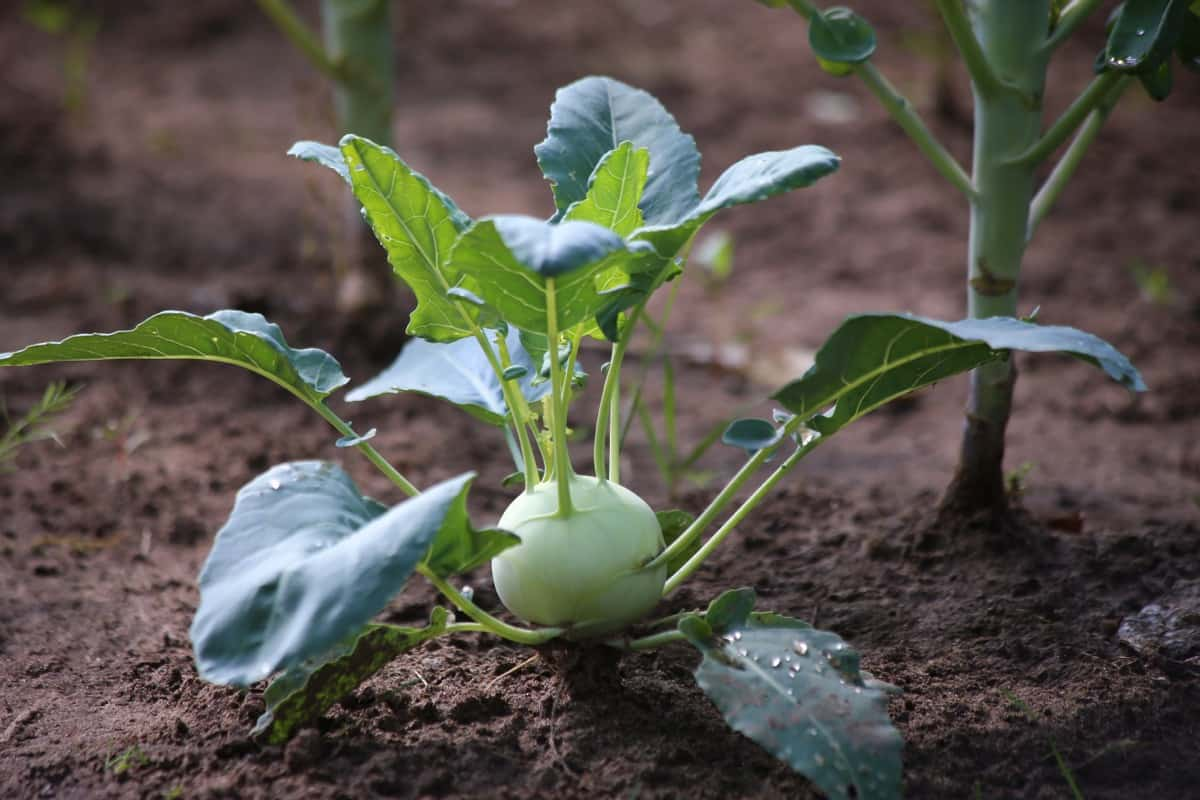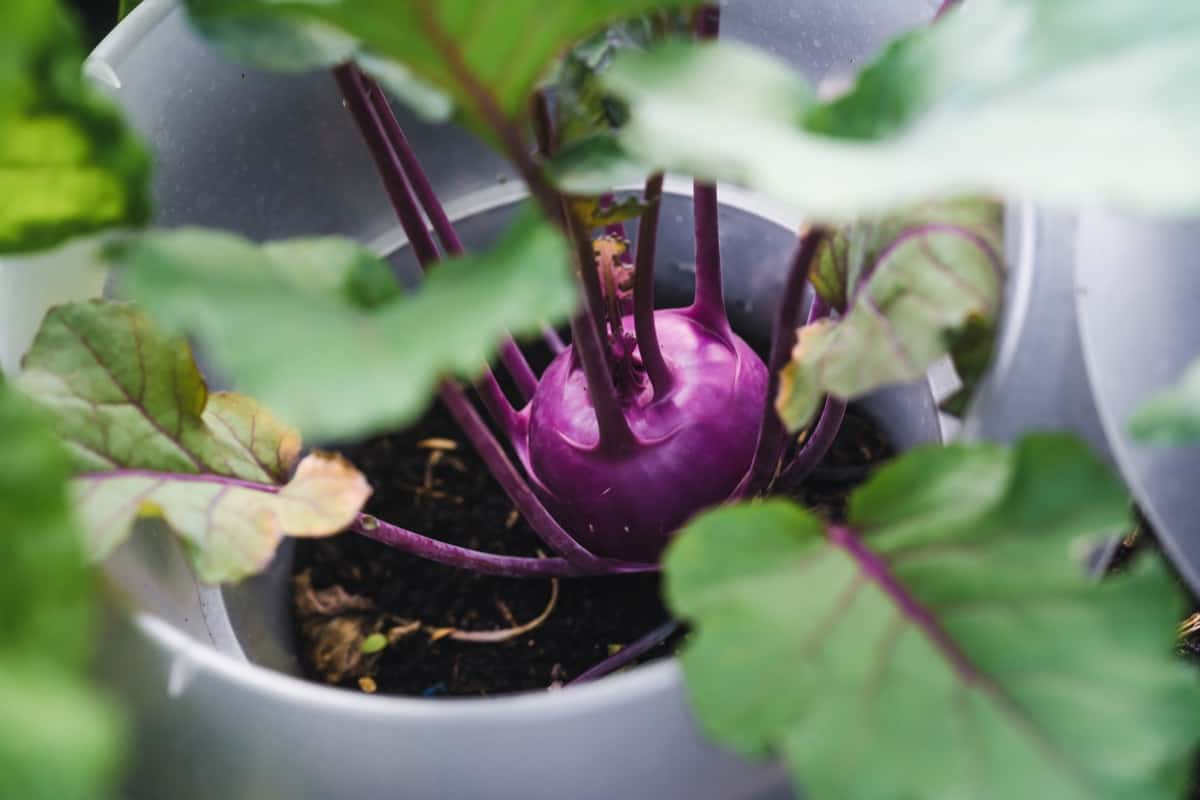Like other plants, Kohlrabi plants can face various problems hindering their growth and development. Gardeners and plant enthusiasts need to know these common problems and their treatments and solutions. This article will discuss ten common problems with kohlrabi plants and provide effective ways to address them.

10 Common Problems With Kohlrabi Plants
Why Are My Kohlrabi Leaves Turning Yellow?
- Overwatering: Yellow leaves can be caused by overwatering. Ensure you water your kohlrabi plants properly. The soil should be allowed to dry out between watering sessions.
- Nutrient deficiency: Yellowing leaves can also indicate a nutrient deficiency, particularly nitrogen. Consider using a balanced fertilizer to provide nutrients for your kohlrabi plants.
- Pest infestation: Certain pests, such as aphids or cabbage worms, can cause yellowing of kohlrabi leaves. Use appropriate pest control measures to eliminate these pests from your garden.
- Disease: Diseases like clubroot or downy mildew can cause the yellowing of kohlrabi leaves. Ensure proper crop rotation and practice good sanitation to prevent the spread of diseases.
- Environmental stress: Extreme temperatures or excessive sun exposure can lead to the yellowing of kohlrabi leaves. Provide shade or use row covers to protect your plants from harsh weather conditions.
How to Prevent Pests From Attacking Kohlrabi Plants
Aphids: Aphids are soft-bodied small insects that feed on the sap of kohlrabi plants. They can be found clustered on the undersides of leaves or near the growing points of the plants. If aphids are detected, they can be controlled using insecticidal soap or neem oil spray.
Cabbage Worms: They feed on the leaves of kohlrabi plants, leaving behind large holes and causing significant damage. To prevent cabbage worms, it is recommended to use biological control methods such as introducing natural predators like parasitic wasps or applying Bacillus thuringiensis (Bt) insecticide.
Flea Beetles: They attack kohlrabi plants by feeding on the leaves, resulting in small holes and stunted growth. Covering the plants with floating row covers can provide a physical barrier that prevents flea beetles from reaching the plants.
In case you missed it: Frequently Asked Questions About Growing Kohlrabi from Seed to Harvest

Why Are My Kohlrabi Plants Wilting?
One common reason for kohlrabi plant wilting is insufficient watering. Like most plants, kohlrabi requires an adequate amount of water to thrive. If the soil is too dry, the plants may be unable to access the necessary moisture, leading to wilting. On the other hand, overwatering can also cause wilting by drowning the roots and preventing proper oxygenation.
Finding the right balance and ensuring the plants receive consistent, but not excessive, moisture. And also, environmental factors play a significant role in kohlrabi plant wilting as well. Extreme heat or cold can stress the plants and cause wilting. Providing adequate shade or protection during hot summer days or frosty nights can help prevent wilting due to temperature extremes.
How to Treat Fungal Diseases in Kohlrabi Plants
- Proper Sanitation: Start by removing any infected plant material from the garden, such as leaves or stems. Dispose of these materials in a sealed bag or burn them to stop the spread of fungal spores.
- Fungicide Application: Fungicides containing active ingredients like copper or sulfur can be effective against fungal diseases in kohlrabi plants.
- Water Management: Avoid overwatering your kohlrabi plants, as excess moisture can create a favorable environment for fungal growth. Instead, water the plants at the base and keep the foliage dry.
- Adequate Spacing: Provide enough space between kohlrabi plants to ensure proper air circulation. This will help reduce humidity levels and minimize the risk of fungal infections.
- Crop rotation: Rotate your kohlrabi plants with other unrelated crops each year to disrupt the lifecycle of fungal pathogens. This practice can reduce the buildup of disease-causing organisms in the soil.
Tips for Promoting Healthy Growth in Kohlrabi Plants
- Ensure the soil is well-drained and organically rich. Kohlrabi plants thrive in fertile, slightly acidic soil, with a pH between 6.0 and 7.5.
- Kohlrabi plants require full sun exposure to grow and develop properly. Ensure they receive at least 6 to 8 hours of direct sunlight daily.
- Water them regularly, keeping the soil evenly moist. Avoid overwatering as it leads to root rot.
- Apply an organic mulch around the plant’s base to retain moisture, prevent weed growth, and maintain a more stable soil temperature.
- Use a balanced, slow-release fertilizer or incorporate compost into the soil before planting to provide essential nutrients.
- Plant-to-plant distance should be at least 6 to 8 inches apart for adequate air circulation and prevent overcrowding.
Why Are There Yellow Spots on My Kohlrabi Leaves?
One possible cause of yellow spots on kohlrabi leaves is a fungal or bacterial infection. Diseases such as downy mildew, powdery mildew, or bacterial leaf spot can cause yellow spots on the leaves. These diseases are often spread through contaminated soil, water, or infected plant debris. To prevent the spread of these diseases, practice good garden hygiene, such as removing any infected plant material and avoiding overhead watering.
In case you missed it: A Step-by-Step Guide for Growing Kohlrabi Microgreens: DIY in Simple Way from Seeds in Containers

Certain insects, such as aphids or flea beetles, can cause yellow spots on kohlrabi leaves. These pests feed on plant sap, leading to weakened and discolored foliage. Inspect the leaves for insect activity, including tiny holes or sticky residue. Use insecticidal soaps or other organic pest control methods to manage the infestation.
Preventing Root Rot in Kohlrabi Plants
- Plant your kohlrabi in a well-draining area with good air circulation. Avoid areas where water collects or where the soil is consistently wet.
- If soil is heavy or tends to retain water, add organic matter such as compost or well-rotted manure. This will loosen the soil and allow excess water to drain away.
- Kohlrabi plants need regular watering, but it’s important not to overwater. Water deeply, allowing the soil to dry out slightly between waterings. Avoid watering the plants in the evening, as this can promote fungal growth.
- Applying an organic mulch around the plants’ base can help regulate soil moisture and temperature. Mulch also helps prevent weeds, which can compete with kohlrabi plants for nutrients and water.
How to Deal With Deformed Kohlrabi Bulbs
- Ensure the soil is loose and free from any clumps or compacted areas. This provides the ideal environment for the bulbs to develop properly.
- Overcrowding can lead to competition for resources, resulting in deformed bulbs. Follow the recommended spacing guidelines for the variety you are planting.
- Inconsistent watering can lead to deformed bulbs. Water regularly, ensuring the soil remains evenly moist throughout the growing season.
- Kohlrabi plants require a balanced supply of nutrients to produce healthy bulbs. Incorporate organic matter, compost, or a balanced fertilizer in the soil for optimal growth.
Common Nutritional Deficiencies in Kohlrabi Plants
| Nutrients | Deficiency Symptoms | fertilizers |
| Nitrogen | Pale green or yellow leaves | Ammonium nitrate, urea, blood meal |
| Phosphorus | Purple discoloration of leaves, slow growth, and delayed maturity. | Bone meal, rock phosphate, triple superphosphate |
| Potassium | Leaf edges turning brown or scorched, or tuber development | Potassium sulfate, potassium nitrate, wood ash |
| Calcium | Young leaves and growing points die back, and distorted growth | Gypsum, limestone |
In case you missed it: Homemade Citrus Peel Spray for Pests and Disease Control: Recipe for Natural and Organic Benefits of Plants

Natural Remedies for Common Problems in Kohlrabi Plants
- For pests such as aphids, spray a simple water and dish soap solution or neem oil on the plants to deter them.
- To prevent fungal diseases, ensure proper air circulation around the plants. Additionally, baking soda and water can be sprayed on the leaves to help combat fungal infections.
- Apply compost tea to the soil for nutrient deficiencies to provide the necessary minerals. Regularly inspecting the plants for any signs of problems and taking prompt action can help maintain the health of Kohlrabi plants.
Conclusion
By following these treatment and solution strategies, you can effectively address and overcome the common problems that may arise with kohlrabi plants, ensuring healthy growth and a bountiful harvest.
- Feed Your Flock for Less: Top 10 Tips to Save on Chicken Feed
- Ultimate Guide to Ossabaw Island Hog: Breeding, Raising, Diet, and Care
- Hatching Answers: The Top 10 Reasons Your Chickens Aren’t Laying Eggs
- Eggs and Economics: Breaking Down the Cost of Raising Backyard Chickens
- Defend Your Greens: Proven Methods to Keep Iguanas Out of Your Garden
- Ultimate Guide to Cinnamon Queen Chicken: A Comprehensive Guide for Beginners
- Ultimate Guide to California Tan Chicken: Breeding, Raising, Diet, Egg-Production and Care
- Ultimate Guide to Marsh Daisy Chicken: Breeding, Raising, Diet, and Care
- 10 Types of Chicken Farming Businesses You Can Start for Profits